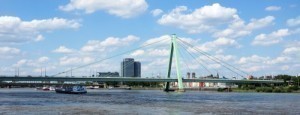When Cologne's Severinsbrücke was inaugurated on November 7, 1959 in the presence of German Chancellor Konrad Adenauer, it was one of the most innovative bridge structures in the world with its asymmetrically positioned triangular pylon. Designed by architect Gerd Lohmer in collaboration with civil engineer Fritz Leonhardt, the steel bridge still impresses today with its architectural and structural quality. The structure, which is now more than sixty years old, was reinforced with hot-dip galvanized steel components.
 The use of hot-dip galvanizing means that follow-up costs due to maintenance measures on the reinforcement components can be ruled out. Photo: Hot-dip galvanizing institute
The use of hot-dip galvanizing means that follow-up costs due to maintenance measures on the reinforcement components can be ruled out. Photo: Hot-dip galvanizing institute
The cable-tensioned beam bridge has a length of 691 meters and is 29.50 meters wide. The largest span is 302 meters. The pylon protrudes 77 meters above the bridge foundation. 8300 tons of steel were used to build the Rhine crossing in 1959. The heavily frequented bridge serves both road and rail traffic. Due to the particular rigidity of the structure, streetcars initially ran over the bridge on grooved rails. Since the conversion in 1979/1980, the light rail vehicles have used their own track on the bridge. In 2014, the decision was made to reinforce the Severins Bridge in the area of the main girder boxes and in the pylon. As the reinforcements are not visible from the outside, the appearance of the bridge was preserved.
The plates of the main girder boxes were strengthened by installing U-profiles at right angles to the existing buckling stiffeners. In the area of the box girder webs, UPE 270 and UPE 300 were used, which were bolted to the existing buckling stiffeners (L-profiles). To attach the U-profiles to the base and cover plates, L-profiles with welded-on intermediate plates (steel plates) were used in the direction of the existing buckling stiffeners. The wall plates in the pylon stems were also reinforced by installing U-profiles (UPE 240/UPE 270). They were installed at right angles to the existing buckling stiffeners and bolted to the existing U-profiles using intermediate plates (steel plates).
The corrosion protection of the reinforcement components was of paramount importance. In contrast to the coated existing elements of the Severins Bridge, the reinforcement components were to be given maintenance-free corrosion protection.  The Severins Bridge in Cologne was inaugurated in 1959 in the presence of Federal Chancellor Konrad Adenauer. Photo: Rolf HeinrichIn addition,it had to be taken into account that the reinforcement components had to be transported and installed by hand inside the pylon and the main girder boxes, which meant that the steel components were exposed to heavy mechanical loads during the construction phase. Due to these requirements, corrosion protection by hot-dip galvanizing was the optimal and economical solution.
The Severins Bridge in Cologne was inaugurated in 1959 in the presence of Federal Chancellor Konrad Adenauer. Photo: Rolf HeinrichIn addition,it had to be taken into account that the reinforcement components had to be transported and installed by hand inside the pylon and the main girder boxes, which meant that the steel components were exposed to heavy mechanical loads during the construction phase. Due to these requirements, corrosion protection by hot-dip galvanizing was the optimal and economical solution.
Thanks to the structural reinforcement, the Severin Bridge will continue to be available as an important Rhine crossing for motor vehicle and rail traffic. The use of hot-dip galvanizing means that follow-up costs due to maintenance measures on the reinforcement components can be ruled out.
More information on hot-dip galvanizing in bridge construction: www.feuerverzinken.com/bruecken


